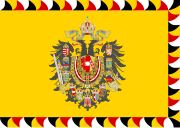The Supreme Commander of the Imperial and Royal Armed Forces (German: Oberkommandierender der Streitkräfte von Österreich-Ungarn; Hungarian: A Császári és Király Fegyveres Erők Főparancsnoka) was the ultimate authority of the Austro-Hungarian Armed Forces – which comprised the Army, Navy and Aviation Troops of Austria-Hungary.
 |
 |
 |
 |
Highest Commander-in-Chief
editThe Supreme Commander was usually the Emperor of Austria as Highest Commander-in-Chief (Allerhöchste Oberbefehl; Legmagasabb Főparancsnok).[1] The Emperor ran the armed forces (Bewaffnete Macht or Wehrmacht) through the Military Chancellery of His Imperial and Royal Majesty the Emperor-King (Militärkanzlei Seiner Majestät des Kaisers and Königs; Őfelsége a Császár-Király Katonai Kancelláriájá) that was established on 11 July 1867. Amongst its heads, who usually bore the title Adjutant General (Generaladjutant), were:
- Friedrich von Beck-Rzikowsky (11 Jul 1867–1881)
- Arthur Freiherr von Bolfras (1889–5 Jan 1917)
In his old age Franz Joseph I only rarely exercised the function of supreme commander in person. Instead, in 1905 after the death of Field Marshal Archduke Albert — who had taken over the post in 1866 from General Benedek and held it until his death in 1895[2] — he appointed Archduke Friedrich of Austria-Teschen as his representative using the style: At the disposal of the Supreme Commander - His Imperial and Royal Highness General of Infantry and Inspector of the Army Archduke Friedrich (Zur Disposition des Allerhöchsten Oberbefehls - se. k.u.k. Hoheit General der Infanterie und Armeeinspektor Erzherzog Friedrich).[3]
Besides Friedrich, whose duties were mainly ceremonial, Archduke Franz Ferdinand had a great influence on the armed forces in the last years of the monarchy, and worked hard to keep them united and to expand them. In 1898, after a career as an officer, he was appointed "at the disposal of the Supreme Commander" (zur Disposition des Allerhöchsten Oberbefehles),[4] in order to oversee the army as a whole as well as the navy. To that end, from 1899, he maintained his own military chancellery (headed from Dec 1905 to autumn 1911 by Alexander Brosch von Aarenau and from autumn 1911 to June 1914 by Carl von Bardolff), at Belvedere Palace, which was successively expanded by Brosch into a secondary government (Nebenregierung). In 1913 the heir to the Emperor was appointed as Inspector General of the Armed Forces (Generalinspektor der gesamten bewaffneten Macht);[5] at his request Franz Joseph I appointed General Conrad as Chief of the General Staff (1906–1911 and 1912–1 Mar 1917). The CGS, since the reform of 1895 called the CGS of the Armed Forces (Chef des Generalstabs für die gesamte bewaffnete Macht), had the right to a personal audience with the monarch (without the presence of the Minister of War), whereby the CGS was superior to the Defence Ministry as well as the Imperial Chancellery, and the Inspector General of Troops was subordinated to him; only the heir apparent outranked him.
At the onset of World War I, the Emperor appointed Friedrich as commander in chief, following the usual practice in times of crisis to appoint a serving officer to exercise high command of the army. Friedrich assumed this function until 2 Dec 1916, when the new Emperor, Charles I, took over supreme command himself.
Charles himself gave up the supreme command at the end of the war, in order not to have to sign the peace treaty and terms of surrender personally.[6]
List of officeholders
editSupreme commanders
edit| No. | Portrait | Supreme commander | Took office | Left office | Time in office | Ref. |
|---|---|---|---|---|---|---|
| 1 | His k.u.k. Apostolic Majesty Franz Joseph I of Austria (1830–1916) [a] | 1848 | 1914 | 65–66 years | . | |
| 2 | His k.u.k. Highness Field marshal Archduke Friedrich, Duke of Teschen (1856–1936) [b] | 11 July 1914 | 2 December 1916 | 1 year, 360 days | . | |
| 3 | His k.u.k. Apostolic Majesty Grand Admiral and Colonel General Charles I of Austria (1887–1922) [c] | 2 December 1916 | 3 November 1918 | 1 year, 336 days | [7][6] | |
| 4 | Field marshal Hermann Kövess von Kövessháza (1854–1924) [d] | 3 November 1918 | 1 December 1918 | 28 days | [6] |
Deputies
edit| No. | Portrait | Deputy | Took office | Left office | Time in office | Supreme commander | Ref. |
|---|---|---|---|---|---|---|---|
| 1 | His k.u.k. Highness Field marshal Archduke Albrecht, Duke of Teschen (1817–1895) [e] | 1866 | 18 February 1895 † | 28–29 years | Franz Joseph I of Austria | [2] | |
| Vacant Feb 1895 – 1898 | |||||||
| 2 | His k.u.k. Highness General of Cavalry and Admiral Archduke Franz Ferdinand of Austria (1863–1914) [f] | 1898 | 28 Jun 1914 † | 15–16 years | Franz Joseph I of Austria | [4] | |
| 3 | His k.u.k. Highness General of Infantry and Inspector of the Army Archduke Friedrich, Duke of Teschen (1856–1936) [g] | 1905 | 1913 | 7–8 years | Franz Joseph I of Austria | . | |
| Vacant 1913 – 1916 | |||||||
| (3) | His k.u.k. Highness General of Infantry and Inspector of the Army Archduke Friedrich, Duke of Teschen (1856–1936) | 2 December 1916 | 11 February 1917 | 71 days | Charles I of Austria | . | |
| Vacant Feb 1917 – Nov 1918 | |||||||
| 4 | Colonel General Arthur Arz von Straußenburg (1857–1935) [h] | 4 November 1918 | 1 December 1918 | 27 days | Hermann Kövess von Kövessháza | [6] | |
See also
editNotes
edit- ^ Emperor and Apostolic King (Kaiser and apostol. König), etc., Supreme Commander (Allerhöchster Oberbefehl) (2 Dec 1848 Emperor; 27 Feb 1895 Prussian GFM)
- ^ Supreme Commander of All Armed Forces (Oberkommandierender der gesamten bewaffneten Macht)
- ^ Emperor and Apostolic King, etc., Supreme Commander (Kaiser and apostol. König, etc., Allerhöchster Oberbefehl) (Gen of Cav and Adm; 1 Nov 1916 Grand Adm and Col Gen; 21 Nov 1916 Emperor; 12 Feb 1917 Prussian GFM)
- ^ Army commander (Armeeoberkommandant) (was commander of the army group in the western Balkans; 5 Aug 1917 FM)
- ^ Inspector General of the Armed Forces (Generalinspektor der gesamten bewaffneten Macht) (04 Apr 1863 FM; 3 Jul 1874 Russian GFM, 27 Nov 1893 Prussian GFM)
- ^ at the disposal of the Supreme Commander; from 1913 Inspector General of the Armed Forces (Generalinspektor der gesamten bewaffneten Macht)[8] (26 September Heir apparent; 26 Apr 1899 Gen of Cav; 4 Sep 1902 Adm)
- ^ at the disposal of the supreme commander (08 Dec 1914 FM; 15 Nov 1908 Prussian GFM)
- ^ Chief of the General Staff of the k.u.k Army (26 Feb 1918 Col Gen; 2 Mar 1917 Chief of the General Staff)
References
edit- Antonio Schmidt-Brentano (January 2007), Österreichisches Staatsarchiv (ed.), Die k. k. bzw. k. u. k. Generalität 1816-1918, Vienna
{{citation}}: CS1 maint: location missing publisher (link)
- ^ Allerhöchsten Oberbefehl - Seine Majesty der Kaiser und König - Franz Joseph I ("Supreme Commander – His Majesty the Emperor and King – Franz Joseph I") was the official designation of the commander-in-chief until 1916
- ^ a b c.f Lit. Zeinar, Hubert (2006). Geschichte des österreichischen Generalstabes (in German). Böhlau Verlag Wien. pp. 455 and footnote 336. ISBN 978-3-205-77415-0.
- ^ Also the official designation
- ^ a b Lit. Zeinar, Hubert (2006). Geschichte des österreichischen Generalstabes. Böhlau Verlag Wien. pp. 416, footnote 251. ISBN 978-3-205-77415-0. Franz Joseph already decided in 1908 that when the time came, he would assign the high command to his heir. Zeinar, Hubert (2006). Geschichte des österreichischen Generalstabes (in German). Böhlau Verlag Wien. pp. 455 and footnote 336. ISBN 978-3-205-77415-0.
- ^ Friedrich Weissensteiner: Franz Ferdinand. Der verhinderte Herrscher, Österreichischer Bundesverlag, Vienna, 1983, ISBN 3-215-04828-0, pp. 200 ff.
- ^ a b c d 31 Oct: disbandment of the Common Army, 11 Nov: demobilisation, pensioning off the generals by 1 Dec 1818; detailed to command November 1918, see:
Georg Reichlin-Meldegg, Bundesministerium für Landesverteidigung and Sport/Österreichs Bundesheer (ed.), "Field marshal Hermann Baron Kövess von Kövessháza", Truppendienst, vol. Folge 306, no. Ausgabe 6/2008, Vienna, pp. o.A
Lit. Zeinar, Hubert (2006). "Colonel General Arthur Albert Freiherr Arz von Straussenburg – Der letzte Generalstabschef of Austria-Hungary von 1917 bis 1918". Geschichte des österreichischen Generalstabes (in German). Böhlau Verlag Wien. pp. 292–298. ISBN 978-3-205-77415-0. - ^ "in exercise of his sovereign right", order of the day on 2 December 1916
- ^ c.f. Zeinar (2006), Bindung an den allerhöchsten Oberbefehl, p. 544
Literature
edit- Zeinar, Hubert (2006), Geschichte des österreichischen Generalstabes, Vienna: Böhlau, ISBN 978-320577415-0
- The Army of Francis Joseph by Gunther E. Rothenberg